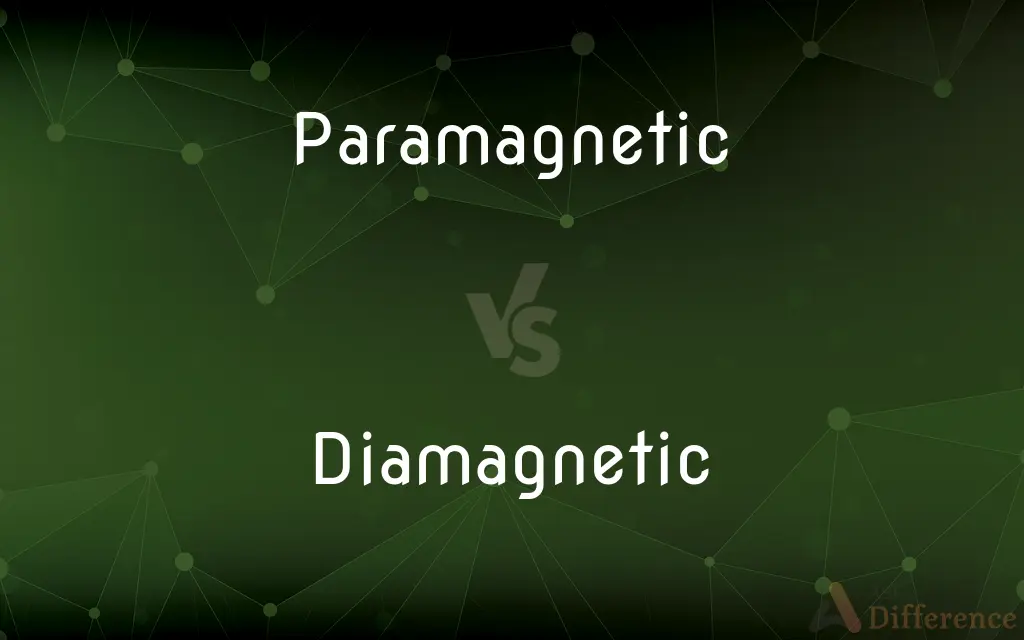Paramagnetic vs. Diamagnetic — What's the Difference?
By Urooj Arif & Maham Liaqat — Updated on March 25, 2024
Paramagnetic materials are attracted by magnetic fields, while diamagnetic materials are repelled.

Difference Between Paramagnetic and Diamagnetic
Table of Contents
ADVERTISEMENT
Key Differences
Paramagnetic materials possess unpaired electrons, making them attracted to external magnetic fields. These materials, including aluminum and oxygen, exhibit magnetism only when an external field is applied and do not retain magnetic properties after its removal. Diamagnetic materials, such as copper and water, have all electrons paired and create an induced magnetic field in opposition to an applied magnetic field, leading to a repulsive effect.
While the magnetic susceptibility of paramagnetic materials is positive, indicating attraction to magnetic fields, diamagnetic materials have a negative magnetic susceptibility, showing a natural repulsion. This fundamental difference affects how they interact with magnetic fields, with paramagnetic materials strengthening and focusing magnetic lines of force and diamagnetic materials doing the opposite.
In practical applications, paramagnetic materials can be used in magnetic resonance imaging (MRI) and other technologies that rely on magnetic fields. Diamagnetic materials, on the other hand, are used in magnetic levitation experiments and applications where a repulsive magnetic force is beneficial.
The effect of magnetism in paramagnetic materials is generally weaker than in ferromagnetic materials (which are strongly attracted to magnets), but stronger than in diamagnetic materials. This difference in strength of interaction with magnetic fields underlies many of their technological and scientific applications.
Comparison Chart
Electron Configuration
Unpaired electrons
All electrons paired
ADVERTISEMENT
Magnetic Susceptibility
Positive
Negative
Reaction to Magnetic Fields
Attracted
Repelled
Retention of Magnetism
Does not retain magnetism after field is removed
Not applicable (always repelled)
Examples
Aluminum, oxygen
Copper, water
Applications
MRI technology, magnetic storage
Magnetic levitation, minimizing magnetic disturbances
Compare with Definitions
Paramagnetic
Exhibits magnetism only in the presence of an external magnetic field.
Oxygen in its paramagnetic state enhances MRI images.
Diamagnetic
Exhibits induced magnetic fields in opposition to applied ones.
Water is used in diamagnetic levitation experiments due to its repulsion from magnets.
Paramagnetic
Does not retain magnetic properties without an external field.
Once the magnetic field is removed, a paramagnetic substance like platinum loses its magnetism.
Diamagnetic
Always repelled by magnetic fields.
Graphite's diamagnetic properties allow it to levitate above strong magnets.
Paramagnetic
Materials with unpaired electrons.
Aluminum is paramagnetic and is attracted to a magnetic field.
Diamagnetic
Materials where all electrons are paired.
Bismuth is diamagnetic, showing a repulsive reaction to magnetic fields.
Paramagnetic
Relating to or being a substance in which an induced magnetic field is parallel and proportional to the intensity of the magnetizing field but is much weaker than in ferromagnetic materials.
Diamagnetic
Of or relating to a substance that generates a magnetic field in the direction opposite to an externally applied magnetic field and is therefore repelled by it.
Paramagnetic
(physics) Exhibiting paramagnetism.
Diamagnetic
(physics) Exhibiting diamagnetism; repelled by a magnet.
Paramagnetic
Having or exhibiting paramagnetism; - opposed to diamagnetic and contrasted with ferromagnetic.
Diamagnetic
Any substance that exhibits diamagnetism.
Paramagnetic
Of or relating to a paramagnet
Diamagnetic
Pertaining to, or exhibiting the phenomena of, diamagnetism; taking, or being of a nature to take, a position at right angles to the lines of magnetic force. See Paramagnetic.
Diamagnetic
Any substance, as bismuth, glass, phosphorous, etc., which in a field of magnetic force is differently affected from the ordinary magnetic bodies, as iron; that is, which tends to take a position at right angles to the lines of magnetic force, and is repelled by either pole of the magnet. Contrasted with paramagnetic and ferromagnetic.
Diamagnetic
Relating to or exhibiting diamagnetism; slightly repelled by a magnet
Common Curiosities
What is paramagnetism?
Paramagnetism is a form of magnetism where materials are attracted to magnetic fields due to the presence of unpaired electrons.
Can the magnetic properties of paramagnetic materials be permanent?
No, paramagnetic materials do not retain magnetic properties once the external magnetic field is removed.
What defines a material as diamagnetic?
A diamagnetic material is characterized by having all its electrons paired up, resulting in a repulsion from magnetic fields.
How are paramagnetic materials used in technology?
They are used in various applications including magnetic resonance imaging (MRI) and as components in magnetic storage devices.
How do paramagnetic and diamagnetic materials differ in their reaction to magnetic fields?
Paramagnetic materials are attracted to magnetic fields, whereas diamagnetic materials are repelled by them.
What role do unpaired electrons play in magnetism?
Unpaired electrons generate magnetic moments that align with external magnetic fields, leading to attraction in paramagnetic materials.
Why are diamagnetic materials repelled by magnetic fields?
Diamagnetic materials create an induced magnetic field in the opposite direction of the applied magnetic field, leading to repulsion.
Is water paramagnetic or diamagnetic?
Water is diamagnetic, meaning it is repelled by magnetic fields.
What happens to a diamagnetic material in a strong magnetic field?
It will be repelled by the field, potentially allowing for levitation if the magnetic force is strong enough.
Are the effects of diamagnetism strong?
The effects are usually very weak compared to those of ferromagnetism or paramagnetism and are often observable only under strong magnetic fields.
What are practical applications of diamagnetic materials?
Diamagnetic materials are utilized in magnetic levitation experiments and in technologies that require the minimization of magnetic disturbances.
Can the magnetic properties of a material change under different conditions?
Yes, changes in temperature, pressure, or chemical composition can alter the magnetic properties of a material.
How does temperature affect paramagnetic materials?
Generally, increasing temperature decreases the magnetic susceptibility of paramagnetic materials due to increased thermal agitation.
Can all materials be classified as either paramagnetic or diamagnetic?
Most materials exhibit some level of diamagnetism, but they can also have paramagnetic, ferromagnetic, or antiferromagnetic properties depending on their electron configurations.
Why don't diamagnetic materials retain magnetism?
Because their magnetism is solely induced by external fields and acts in opposition to those fields, not aligning with them.
Share Your Discovery

Previous Comparison
Frizzle vs. Drizzle
Next Comparison
Outskirt vs. SuburbAuthor Spotlight
Written by
Urooj ArifUrooj is a skilled content writer at Ask Difference, known for her exceptional ability to simplify complex topics into engaging and informative content. With a passion for research and a flair for clear, concise writing, she consistently delivers articles that resonate with our diverse audience.
Co-written by
Maham Liaqat















































